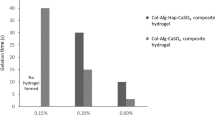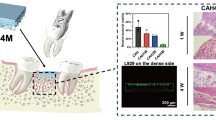Abstract
Bone regeneration ability of a scaffold strongly depends on its structure and the size of its components. In this study, a nanostructured scaffold was designed for bone repair using nano hydroxyapatite (nHA) (8–16 nm × 50–80 nm) and gelatin (GEL) as main components. In vitro investigations of calcium matrix deposition and gene expression of the seeded cells for this scaffold, demineralized bone matrix (DBM), scaffold plus DBM, and the control group were carried out. Bone regeneration in rat calvarium with critical defect size after 1, 4, and 8 weeks post implantation was investigated. The calcium matrix depositions by the osteoblast and RUNX2, ALP, osteonectin, and osteocalcin gene expression in scaffold were more significant than in other groups. Histomorphometry analysis confirmed in vitro results. In vitro and in vivo bone regeneration were least in scaffold plus DBM group. Enhanced effects in scaffold could be attributed to the shape and size of nHA particles and good architecture of the scaffold. Reduction of bone regeneration might be due to tight bonding of BMPs and nHA particles in the third group. Results obtained from this study confirmed that nano-scale size of the main components and the scaffold architecture (pore diameter, interconnectivity pores, etc.) have significant effects on bone regeneration ability of the scaffold and are important parameters in designing a temporary bone substitute.







Similar content being viewed by others
References
Abdel-Gawad EI, Awwad S (2010) Biocompatibility of intravenous nano hydroxyapatite in male rats. Nat Sci 8:60–68
Akay G, Birch MA et al (2004) Microcellular polyHIPE polymer supports osteoblast growth and bone formation in vitro. Biomaterials 25(18):3991–4000
Alper G, Bernick SOL et al (1989) Osteogenesis in bone defects in rats: the effects of hydroxyapatite and demineralized bone matrix. Am J Med Sci 298(6):371
Aronow MA, Gerstenfeld LC et al (1990) Factors that promote progressive development of the osteoblast phenotype in cultured fetal rat calvaria cells. J Cell Physiol 143(2):213–221
Askarzadeh K, Orang F et al (2005) Fabrication and characterization of a porous composite scaffold based on gelatin and hydroxyapatite for bone tissue engineering. Iran Polym J 14(6):511–520
Azami M, Samadikuchaksaraei A et al (2010) Synthesis and characterization of a laminated hydroxyapatite/gelatin nanocomposite scaffold with controlled pore structure for bone tissue engineering. Int J Artif Organs 33(2):86–95
Catledge SA, Fries MD et al (2002) Nanostructured ceramics for biomedical implants. J Nanosci Nanotechnol 23(4):293–312
Chen L, Joseph MM, James C-ML, Hao L (2011) The role of surface charge on the uptake and biocompatibility of hydroxyapatite nanoparticles with osteoblast cells. Nanotechnology 22(10):105708
Dallari D, Savarino L et al (2012) A prospective, randomised, controlled trial using a Mg-hydroxyapatite-demineralized bone matrix nanocomposite in tibial osteotomy. Biomaterials 33(1):72–79
Dvorak MM, Riccardi D (2004) Ca2+ as an extracellular signal in bone. Cell Calcium 35(3):249–255
George J, Kuboki Y et al (2006) Differentiation of mesenchymal stem cells into osteoblasts on honeycomb collagen scaffolds. Biotechnol Bioeng 95(3):404–411
Götz W, Lenz S, Reichert C, Kai-Olaf et al (2010) A preliminary study in osteoinduction by a nano-crystalline hydroxyapatite in the mini pig. Folia Histochem Cytobiol 48:589–596
Hassenkam T, Fantner GE et al (2004) High-resolution AFM imaging of intact and fractured trabecular bone. Bone 35(1):4–10
Hu J, Liu ZS et al (2007) Effect of hydroxyapatite nanoparticles on the growth and p53/c-Myc protein expression of implanted hepatic VX ~ 2 tumor in rabbits by intravenous injection. World J Gastroenterol 13(20):2798
Karageorgiou V, Kaplan D (2005) Porosity of 3D biomaterial scaffolds and osteogenesis. Biomaterials 26(27):5474–5491
Kartsogiannis V, Ng KW (2004) Cell lines and primary cell cultures in the study of bone cell biology. Mol Cell Endocrinol 228(1–2):79–102
Kim HW, Kim HE et al (2005) Stimulation of osteoblast responses to biomimetic nanocomposites of gelatin-hydroxyapatite for tissue engineering scaffolds. Biomaterials 26(25):5221–5230
Laurencin CT, Ambrosio AMA et al (1999) Tissue engineering: orthopedic applications. Annu Rev Biomed Eng 1(1):19–46
Liao S, Tamura K et al (2006) Human neutrophils reaction to the biodegraded nano hydroxyapatite/collagen and nano hydroxyapatite/collagen/poly (l-lactic acid) composites. J Biomed Mater Res A 76(4):820–825
Liu Y, Lu Y et al (2009) Segmental bone regeneration using an rhBMP-2-loaded gelatin/nanohydroxyapatite/fibrin scaffold in a rabbit model. Biomaterials 30(31):6276–6285
Maeno S, Niki Y et al (2005) The effect of calcium ion concentration on osteoblast viability, proliferation and differentiation in monolayer and 3D culture. Biomaterials 26(23):4847–4855
Mobini S, Javadpour J et al (2008) Synthesis and characterisation of gelatinnano hydroxyapatite composite scaffolds for bone tissue engineering. Adv Appl Ceram 107(1):4–8
Okamoto Y, Horisaka Y et al (1991) Muscle tissue reactions to implantation of bone matrix gelatin. Clin Orthop Relat Res 263:242
Olszta MJ, Cheng X et al (2007) Bone structure and formation: a new perspective. Mater Sci Eng, R 58(3–5):77–116
Otsuki B, Takemoto M, Fujibayashi S, Neo M, Kokubo T, Nakamura T (2006) Pore throat size and connectivity determine bone and tissue ingrowth into porous implants: three dimensional micro-CT based structural analyses of porous bioactive titanium implants. Biomaterials 27(35):5892–5900
Papay FA, Morales L Jr et al (1996) Comparison of ossification of demineralized bone, hydroxyapatite, Gelfoam, and bone wax in cranial defect repair. J Craniofac Surg 7(5):347
Petit R (1999) The use of hydroxyapatite in orthopaedic surgery: a ten-year review. Euro J Ortho Surg Trauma 9(2):71–74
Pezzatini S, Solito R et al (2006) The effect of hydroxyapatite nanocrystals on microvascular endothelial cell viability and functions. J Biomed Mater Res A 76(3):656–663
Phillips MJ, Darr JA et al (2003) Synthesis and characterization of nano-biomaterials with potential osteological applications. J Mater Sci Mater Med 14(10):875–882
Pi M, Faber P et al (2005) Identification of a novel extracellular cation-sensing G-protein-coupled receptor. J Biol Chem 280(48):40201
Rabie ABM, Lie Ken Jie RKP (1996) Integration of endochondral bone grafts in the presence of demineralized bone matrix. Int J Oral Maxillofac Surg 25(4):311–318
Saunders R, Szymczyk KH et al (2007) Matrix regulation of skeletal cell apoptosis III: mechanism of ion pair induced apoptosis. J Cell Biochem 100(3):703–715
Sicchieri LG, Crippa GE et al (2012) Pore size regulates cell and tissue interactions with PLGA-CaP scaffolds used for bone engineering. J Tissue Eng Regen Med 6(2):155–162
Sikavitsas VI, Temenoff JS et al (2001) Biomaterials and bone mechanotransduction. Biomaterials 22(19):2581–2593
Takaoka K, Nakahara H et al (1988) Ectopic bone induction on and in porous hydroxyapatite combined with collagen and bone morphogenetic protein. Clin Orthop Relat Res 234:250
Tang R, Wang L et al (2004) Dissolution at the nanoscale: self preservation of biominerals. Angew Chem 116(20):2751–2755
Thein-Han WW, Misra RDK (2009) Three-dimensional chitosan-nanohydroxyapatite composite scaffolds for bone tissue engineering. JOM 61(9):41–44
Webster TJ (2003) Nanophase ceramics as improved bone tissue engineering materials. Am Ceram Soc Bull 82(6):23–28
Woodard JR, Hilldore AJ et al (2007) The mechanical properties and osteoconductivity of hydroxyapatite bone scaffolds with multi-scale porosity. Biomaterials 28(1):45–54
Zhao Y, Zhang Y et al (2007) Synthesis and cellular biocompatibility of two kinds of HAP with different nanocrystal morphology. J Biomed Mater Res B Appl Biomater 83(1):121–126
Acknowledgments
This study was supported by grant from the School of Advanced Medical Technologies, the Tehran University of Medical Sciences. The authors thank the Iranian Tissue Bank Research & Preparation Center of Imam Khomeini Medical Hospital Complex for supplying DBM.
Author information
Authors and Affiliations
Corresponding author
Rights and permissions
About this article
Cite this article
Tavakol, S., Ragerdi Kashani, I., Azami, M. et al. In vitro and in vivo investigations on bone regeneration potential of laminated hydroxyapatite/gelatin nanocomposite scaffold along with DBM. J Nanopart Res 14, 1265 (2012). https://doi.org/10.1007/s11051-012-1265-y
Received:
Accepted:
Published:
DOI: https://doi.org/10.1007/s11051-012-1265-y




